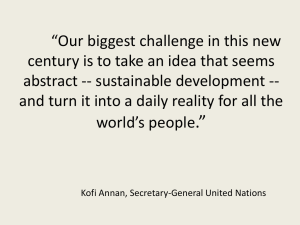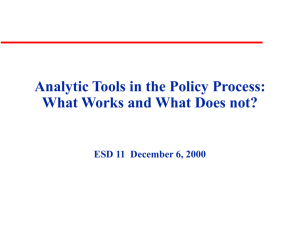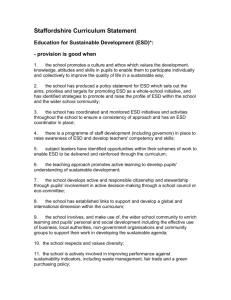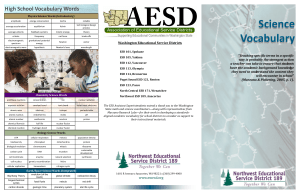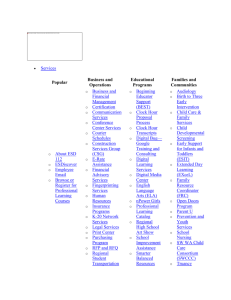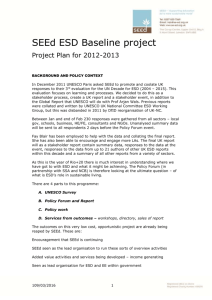Engaging Faculties of Education Manitoba 2009 Chuck Hopkins
advertisement
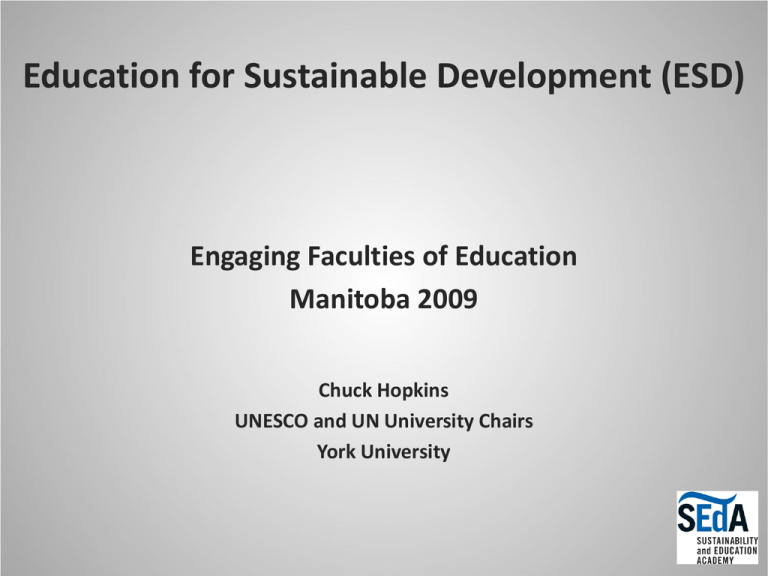
Education for Sustainable Development (ESD) Engaging Faculties of Education Manitoba 2009 Chuck Hopkins UNESCO and UN University Chairs York University science Our pressures on the planet have increased with numbers 14 12 10 6.7 billion (2009) 8 6 4 billion (1975) 4 2 billion (1920) 1 billion (1800) 2 0 500 600 700 800 900 1000 1100 1200 1300 1400 1500 1600 1700 1800 1900 2000 2100 Year Source: UN Population Division 2004; Lee, 2003; Population Reference Bureau Generating great wealth but paying a great price 60 $70 trillion in 2008 50 40 World GDP (trillion 1990 dollars) 30 $10 trillion in 1967 20 $1 trillion in 1900 10 0 500 700 900 1100 1300 1500 1700 1900 2100 Year Source: CIA World Fact Book • Great wealth without FCC – Full Cost Accounting Biomass of Table Fish (tons per km2) 2000 1900 Source: Millennium Ecosystem Assessment; Christensen et al. 2003 From: Steffen et al. 2004 From: Steffen et al. 2004 Our Student’s Eventual Greatest Challenges Provide for 50% more people: using less water using less land using fewer ocean food resources while tripling the global energy – (carbon free) addressing new issues as they emerge developing employable skill sets etc. The Evolving Concept of Sustainable Development • • • • Global Change (environment) Globalization (economic) Human Development (social/culture) Sustainable Development Plus concepts of: • Intergenerational responsibility • Need verses greed /equity • Social justice, etc. Manitoba’s Sustainability Threats • Environmental certainly but also • Social issues such as racism, inclusion, equity, poverty, citizenship, relationships…. • Economic issues such as preparing for the world of work, managing money and larger issues such as creating new opportunities….. • Plus the global issues that face us all. Understanding EE and ESD Environmental Education, Population Education, Development Education, Energy Education, HIV/AIDS Education, Permaculture Education, Citizenship Education, Democracy Education, Consumer Education, Media Education, Outdoor Education, Experiential Education, Workplace Education, Conservation Education, Anti-Racist Education, Religious Education, Equity Education, Gender Education, Holocaust Education, Entrepreneurship Education, Horticulture Education, Water Education, Global Education, Drug Education, Sex Education, International Studies, Family Studies, Human Rights Education, Women's Studies, Native Studies, Values Education, Natural History Education, Vocational Education, Economic Education, Anti-smoking Education, Conflict Resolution Education, Workplace education, Disaster Prevention Education, Computer Studies, LifeSkills Education, Recycling Education, Civics Education, Heritage Education, Community Studies, Multicultural Education, AntiViolence Education, Systems Thinking Education, Futures Education, Biodiversity Education, Pioneer Studies, Nutrition Education, Resource Management Education, Self-Image Education, Peace Education, Leadership Education, Cooperative Education, Character Education, Sexual orientation Education…………….(100 plus) Sustainable Dev. and Education (ESD) • ESD is the potential contribution of the world’s education, public awareness, and training systems to building a more sustainable future. • Thus ESD varies from situation to situation depending on the local/global environmental, social and economic threats both current and emerging Four Major Thrusts of ESD – Access and retention to quality education – Reorienting existing education – Public awareness and understanding – Training programs for all sectors Agenda 21 -92, UNESCO -96, UNCSD -98, JPOI -2002 A Question for All Societies What should our students: • know, • be able to do, • and value, when they graduate? UNESCO – Purpose of Education • • • • • To Know To Do To Become To live together (To live together with “others” sustainably) Global Awakening –Formal Ed. • • • • • • • • Formal education leaders are taking action (CMEC) Collaboration Regional levels – UNECE, Asia Pacific, ESD Indicators are being developed Engagement of core disciplines’ professional organizations ESD research platforms being established New ESD Research Journals Embedding ESD initiatives mainstream projects ESD concept linking to ECE, Spec. ED, TVET, Lifelong learning / adult education • Manitoba an ESD Leader in Canada UN Decade of ESD (2005-2014) • Co-coordinated internationally by UNESCO • Each country/region to develop locally relevant and culturally appropriate response • Formal, non-formal and informal ed. Included • www.unesco.org/education/undesd • Key Agents – Canadian Commission for UNESCO Environment Canada Canadian Council of Ministers of Education UNESCO World Conference on ESD 2009 • 31 March – 2 April 2009, • 900 participants from 150 countries, 48 ministers and vice-ministers • Objectives: to highlight the contribution of ESD to quality education; to promote international exchange on ESD; to take stock of Decade activities; to develop strategies for the way ahead Bonn Declaration – A Call for Action: • “Promote ESD’s contribution to all of education and to achieving quality education” • “Increase public awareness and understanding about sustainable development and ESD” • “Mobilize adequate resources …, in particular through integrating ESD into national development policy and budgetary frameworks” • “Support the incorporation of sustainable development issues [e.g., climate change] using an integrated and systemic approach in formal education as well as in non-formal and informal education at all levels” Bonn Declaration – A Call for Action: At the practice level • “Support the incorporation of sustainable development issues [e.g., climate change] using an integrated and systemic approach in formal education as well as in nonformal and informal education at all levels”, in particular through the development of effective pedagogical approaches, teacher education, teaching practice, curricula, learning materials, and education leadership development. Teacher-educators • Have broad influence – Educate next generation of teachers. – Sit on national curriculum committees. – Write textbooks for elementary & secondary. – Invited to give advice to ministries. – Speak at conferences. – Publish. – At local, regional, and national levels. International Network Formed • Met in 2000, Canada, Baseline reports, Agreed to experiment at home institutions. Set up reporting format. • Met in 2002. South Africa Sent in reports and responded to survey. • Met in 2004. Sweden Reviewed draft of guidelines. • Met in 2006 Finland Establishing regional UNESCO networks • Met in 2008 Turkey - Launch phase 2 Recommendations: Research • Create a research agenda to address important questions, such as the effectiveness of faculty efforts to reorient education to address sustainability. • Develop strong arguments backed by research to submit to academic boards to show that education for the future that does not include ESD is not an appropriate education for the future. Aboriginal Learning Knowledge Centre: Métis Holistic Lifelong Learning Model Redefining Success in Aboriginal Learning Principles of Learning: FN Emerging Model Harmony and Well Being: Individual and Collective Purpose To protect the earth to ensure sustainability of all life. Principles of Learning Holistic (physical, emotional, social and spiritual), experience based and cumulative (life-long) personal and collective (individual and community or societal focused – connected to…natural world, language, traditions and ceremonies, self, family, ancestors, clan, community nations and other nations – intergenerational – nurtured by mentors, elders, guides, etc.) natural or organic, integrated, dynamic evolving process with depth in knowledge (wisdom) emerging as the ultimate outcome circular (self-generating) and available at all stages of life promotes responsibility, adaptability and interdependence respectful of place and the natural order of life at its core it is culturally based – language based and open to new experience and knowledge (Indigenous and Western traditions) can be enhanced or disrupted by physical, social, cultural and political environment (natural, social, economic and political environments) Systemic Challenges for both EE and ESD • • • • • • • • vision and awareness policy or mandate society’s expectation funding and resources training programs crowded curriculum research base models and exemplars OECD ESD Problems • Hard to serve students suffer • Not seen as relevant to testing – reading and math • Poverty related issues • Irrelevant to core curricula • Technical and vocational ed. • Untrained staff • Lack of meaningful equipment The Need for Hope Speak of solutions Our ability to change/survive etc Age appropriate Education verses indoctrination Ministry guidelines and Our need to learn by acting and experimenting now before the worlds poor suffer unbearably! We will change – but when and how! Reorienting Existing Education Currently our most educated nations leave the deepest ecological footprints We have ED systems for Dev. Rather Than SD Reorienting Existing Education We need more ecological handprints!! - From all sources! www.handsforchange.org Infusing EE Means Addressing: Values Principles Perspectives Knowledge Skills But again in a context of education rather than indoctrination Infusing EE into Existing Education Means Addressing: • • • • Buildings Program Practices and actions What we value and what we evaluate • Modeling sustainability SEdA Domains • • • • Governance: policy, goals, mission Curriculum, teaching and learning Human Capacity: professional development Facilities, operations, procurement Community: relationships Commitment: System culture and ethos Leadership Prof Dev. Considerations • Prof development for all employees including leaders • PD and teacher education institutions • Capacity building • Technology transfer for support staff • Rewarding innovative practices Ministries and Faculties of Ed Learning Perspectives • Traditional – Learning as “acquisition” model Knowledge, solutions, true/false right/wrong • Plus – Learning as “participation” model” complexity, reflexive, reflection, negotiation • And – Learning as a “response” model” ambiguity in world, taking charge-life, tolerance, engagement high W I C K E D N E S low S U N C E R T A I N T Y high Strengths Model: A Starting Point for Formal ed. • No single discipline/group/teacher/employee can do it all • Every discipline/group/teacher/employee can contribute something • Some individuals or sectors can take lead roles in directing/managing the reorientation • Leadership and coordination of these “strengths” are key as we “learn” our way forward Industrial Arts Economics The Arts History Literacy Health Math Media Arts Geography Energy savings Science Family Studies IN Phase Two - (2010-2014) Goals 1 - To implement the Guidelines 2 - To develop regional networks 3 - To further refine the Guidelines 4 - To assist in the overarching SD strategies (internationally - local) 5 – Research into ESD competencies, impact, contributions delivery schemes, EfSD vs EuSD

